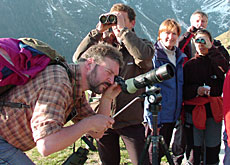Alpine flora blossom in seminal work

Thanks to a 77-year-old Swiss, the plants of the Alps have been photographed almost in their entirety for the first time.
The culmination of 40 years’ work, the photographs of Konrad Lauber have been assembled in a huge encyclopaedia – the most complete work of its kind ever published.
Weighing in at a hefty 5.5 kilograms, the three-volume “Flora Alpina” is colossal in every sense, boasting 2,600 pages and 6,000 colour photos.
Publishers Haupt Verlag describe it as “the most important work we have ever published”.
The encyclopaedia is the brainchild of David Aeschlimann, conservator at the City of Geneva Conservatory and Botanical Gardens, who set the idea in motion in 1997.
Although the Alps loom over eight European countries – France, Germany, Austria, Italy, Switzerland, Liechtenstein, Slovenia, Hungary – Aeschlimann discovered that botanical studies which crossed political boundaries were surprisingly rare.
But as he noted: “Nature doesn’t recognise political boundaries.”
Photo odyssey
Lauber, who provided approximately 95 per cent of the photos in the “Flora Alpina”, experienced this first-hand.
Already in possession of a huge archive at the start of the project, he set out on expeditions to Slovenia, Italy, France and Austria to photograph the rare varieties he still needed.
Aided by numerous tips from fellow hobbyists and regional experts, he was able from 1999-2003 to locate the lion’s share of the 800 plants missing from his 100,000-strong slide collection.
But his expeditions didn’t always go smoothly: sometimes he arrived at a particular spot, only to find that the relevant flowers had already bloomed, or had been destroyed by hail, or had been eaten by goats.
Lauber estimates he probably spent half an hour photographing each flower in his collection.
Endangered
The 4,500 alpine plants featured in the “Flora Alpina” constitute approximately one-third of all European plant life. Of these, perhaps 500 are unique to the Alps.
Of great interest to botanists, they are survivors of the last ice age. Some are exceedingly rare and are to be found only in particular regions of the Alps.
They include three genus with just one species each: the Zwergkugelschötchen (Rhizobotrya alpine), the Berardie (Berardia subacaulis) and the Schopfteufelskralle (Physoplexis comosa).
One species is completely unique to Switzerland: the Engadiner Felsenblümchen (Draba ladina).
Many of these plants are endangered, which is of great concern to the authors of the “Flora Alpina”, who repeatedly emphasise the importance of protecting Europe’s fragile, endemic species.
In addition to Lauber and Aeschlimann, Daniel Martin Moser of the Central Databank for Swiss Flora, and Jean-Paul Theurillat of the J-M Aubert Foundation are co-authors of the “Flora Alpina”.
Mine of information
Supplementing the beautiful photographs is a cornucopia of information, such as location maps, size of flowers, flowering time, and ecological requirements.
The three experts painstakingly sifted through almost half a million pieces of data to put this together.
As plant names are given in German, French, Italian, English, Slovenian and Latin, the encyclopaedia is readily accessible to lay people, from florists to hobbyists to translators.
All plant names were updated to conform to international standards.
“That was really important,” said co-author Jean-Paul Theurillat. “Now the encyclopaedia is also a reference work for botanists. That will greatly ease communication between us.”
The three-volume “Flora Alpina” is the first complete encyclopaedia of alpine plant life ever published.
“Flora Alpina” statistics : 2,600 pages, 6,000 photographs, 5.5 kilograms, cost SFr286 ($233).
95% of the photographs were taken over a 40-year period.
(Adapted from German by Kathleen Peters)

In compliance with the JTI standards
More: SWI swissinfo.ch certified by the Journalism Trust Initiative












You can find an overview of ongoing debates with our journalists here . Please join us!
If you want to start a conversation about a topic raised in this article or want to report factual errors, email us at english@swissinfo.ch.